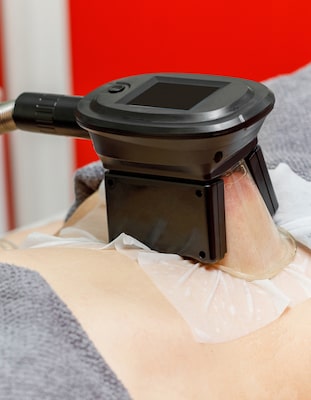
No matter how hard a person works to eliminate fat from the body, there is some fat that is simply resistant to diet and exercise. In order to remove this stubborn fat, some patients turn to a fat freezing process that is known as cryolipolysis (and sometimes referred to as CoolSculpting). The procedure involves the cooling of subcutaneous fat to the point that the fat cells in the targeted area are destroyed and absorbed by the body.
While many patients enjoy the fact that this fat removal treatment is nonsurgical (as opposed to liposuction), there are some risks patients need to know about before they make the decision to address this hard to remove fat.
 The freezing of the fat is accomplished by using a handheld device that contains applicators. The doctor places an applicator, along with a gel pad, on the area targeted for treatment. The applicator will then cool the fat that is in the targeted area of the body. Then, the doctor uses a suction device to remove the fat by moving the device over the area of the skin that is being treated.
The freezing of the fat is accomplished by using a handheld device that contains applicators. The doctor places an applicator, along with a gel pad, on the area targeted for treatment. The applicator will then cool the fat that is in the targeted area of the body. Then, the doctor uses a suction device to remove the fat by moving the device over the area of the skin that is being treated.
As mentioned above, the most commonly treated areas are fatty bulges and sections on the body that are not responding to traditional diet and exercise. Some of the common areas of the body that are treated include the thighs, under the chin, the back, the arms, and the abdomen. The targeted areas enjoy the elimination of fat by cooling the treated area to a very low temperature.
The area of the body with the fat that is being treated is placed in a clamp that is attached to the machine. The fat in the clamp is frozen and damaged so it is destroyed to the point that it will not return.
It is important for patients to know that this treatment is not considered to be a weight loss method and it is not an ideal option for patients who are obese or want to lose weight.
When patients hear the phrase “nonsurgical procedure,” they often jump to the conclusion that there are no risks involved in having the treatment. This is not always the case when it comes to fat freezing (or any other nonsurgical procedure).
Because of the exposure to the extremely cold temperature, the skin can experience some swelling, redness and bruising in the treated area. In addition, patients can experience additional side effects such as numbing, itching, and stinging. Thankfully, these effects are not permanent, and they will resolve on their own within a few weeks.
One of the less common, but still troubling, side effects is the treatment having the opposite intended effect. In other words, the fat increases in size thanks to the freezing process as opposed to the fat dissolving (which is the intended result of the treatment.)
This rare side effect is known as paradoxical adipose hyperplasia and doctors are not quite clear on why this condition happens to some patients. The condition causes the fat cells to grow instead of shrinking in size.
When the procedure does work correctly, the patient can start to lose a good amount of fat even after a single treatment. In general, most patients will begin to see their ideal results after about four weeks, but it could take as long as twelve weeks for the desired results to become visible. The amount of fat that is removed from the body depends on the number of procedures performed on the patient and the amount of stubborn fat that needed to be addressed at the start of the process.
In order to gain the desired results, patients need to schedule an appointment with a doctor who is experienced in performing fat freezing treatments. Besides discussing how the treatment works, the doctor can determine if the person is an ideal candidate for the treatment. In general, the person needs to practice a healthy diet on a regular basis and also be within about twenty pounds of their desired weight.
The doctor of choice should be able to share some “before and after” photos of actual patients they treated in the past so the patient will be able to better visualize the type of results that can occur after the recovery process is completed. The doctor will also need to set realistic expectations so the patient will know what to expect and not be surprised by the results. It is important for the person seeking a fat freezing procedure to be fully informed about the benefits and risks of the treatment as well as the limitations of fat freezing (how much fat can safely be removed and the fact that it is not a weight loss treatment). Once the person has all of the necessary information, a final decision can be made about having a fat freezing treatment.
- MA